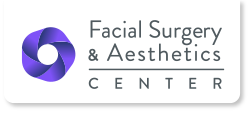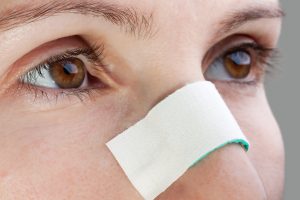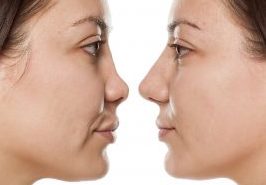
A Nose Cast After Rhinoplasty
Dr. Menachof, MD, FACS has performed thousands of facial plastic surgery procedures in over 20 years of experience. He has been recognized as a Fellow by multiple academies, named one of America’s Top Facial Plastic Surgeons continually since 2003 and is featured in multiple national publications.
There are many different types of rhinoplasty. Some nasal procedures are open while others are closed. Some procedures alter nose bones, while others adjust solely the nostrils or tip of the nose. Your individual nasal needs determine the type of rhinoplasty procedure, and ultimately the healing process afterward. If your recovery process involves a rhinoplasty cast you need to know what to expect, how nose cast removal works, and what you can do to heal from rhinoplasty surgery as quickly as possible.
When Would I Need a Nose Cast After Rhinoplasty?
Many plastic surgeons place tape on the nose following a rhinoplasty to help decrease nasal swelling. Procedures involving the nostrils or tip of the nose will usually be taped for compression. When bones are fractured intentionally during the rhinoplasty procedure (also known as osteotomies), the surgeon will apply an exterior nose cast made of aluminum, plaster, plastic, etc.
The nasal cast will keep the bones in the correct position while the nose swells during the healing process. The rhinoplasty cast purpose is to make sure that the nasal structure is properly supported, and that the patient’s nose will heal properly in its new shape.
This external cast is an important part of preserving your surgical results – one week with a cast is not bad compared to the lifetime of joy your new nose shape will bring. Many nose job failures are the result of incorrect care during the healing process. The management of casts varies patient to patient, which is why it is important to work closely with your surgeon before, during and after the rhinoplasty procedure. They can help you if your rhinoplasty cast fell off, or if the nose cast got wet.
When and How is a Nose Cast Removed?
It takes time for the nasal bones to heal after a rhinoplasty, which is why casts are typically removed six to seven days after surgery. Premature removal of the cast can impact the surgical result. Your surgeon will be able to determine when your cast should be removed.
When possible, have the operating surgeon remove the cast. If this is not feasible, it is possible to do yourself. First, make sure your surgeon agrees it is okay to remove the cast. It is important to be gentle in this process. Begin at the edge of the nose cast and carefully work your way around it to gradually loosen it. If it does not come off easily, wait a day and try again.
It is uncommon for the rhinoplasty cast to fall off on its own. The surgeon will apply an adhesive to ensure that the nose cast stays in place. If you get the rhinoplasty cast wet, there is a higher chance of it falling off. Try not to play or mess with the cast either. If you are careful it should stay on. If your rhinoplasty cast falls off on its own or gets wet, don’t panic. Schedule an appointment with your surgeon, and they will get everything back in place!
What to Expect After Your Rhinoplasty Cast is Removed
When the nose cast is removed, do not make any immediate judgments about the final shape of your nose — rhinoplasty swelling after cast removal is common. Post-operative swelling can also fluctuate from day to day, so be patient. It usually takes a few months for the bones to heal completely and the tissue to settle, and it usually takes a full year before you will see your final results. Again, patience is key during the healing process after you get the rhinoplasty cast off. If you are concerned, contact your surgeon.
Can I Touch My Nose After Cast Removal?
You can touch your nose after the cast is removed, but keep it to a minimum. Speak with your surgeon about how to massage the nose, and how to properly clean the skin. Necessary massage and cleansing will not disturb your rhinoplasty, but unnecessary touching could affect the healing process.
Recovery after rhinoplasty will vary based on the person. Discuss your concerns with your doctor, and give your nose time to heal. After your rhinoplasty cast is removed, you should not be concerned with the swelling and appearance of your nose. As time passes, you will get closer and closer to the final desired result. Give your nose time to recover and follow your surgeon’s direction throughout the rhinoplasty cast process.





